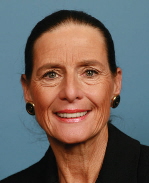Republican Women 2010 U.S. House Voting Record Most Conservative in History
Analysis of National Journal vote rankings finds record highs among female GOP Representatives for conservatism in 2010

Republican women voted more conservatively as a bloc in 2010, in fact, than at any point in modern legislative history.
As in 2009, seven of the 17 female Republicans in the House ranked among National Journal’s Top 50 most conservative in the nation’s lower chamber, led by Jean Schmidt (OH-02, pictured) at #6, Michele Bachmann (MN-06) at #19, Mary Fallin (OK-02) at #31, Virginia Foxx (NC-05) at #33, Sue Myrick (NC-09) at #38, Lynn Jenkins (KS-02) at #42, and Kay Granger (TX-12) at #50.
And the final tally?
A Smart Politics analysis of 30 years of National Journal ideological vote rankings finds that the female Republican members of the U.S. House in 2010 notched both the highest composite conservative score on record as well as the highest conservative component scores for key votes on economic and foreign policy legislation.
(Note: National Journal vote rankings do not measure absolute changes in liberalism or conservatism – only the relative change from one representative to another on a 100-point scale (or, in this case, a group of representatives)).
In 2010, Republican women in the House voted more conservatively than 80 percent of the body as a whole – beating 2009’s previous high of 77.4 percent.
By comparison, when National Journal began its annual ideological vote tracking in 1981, the 10 female Republican Representatives in office that year voted more conservatively than just 54.9 percent of the House as a whole.
Republican women notched their most conservative voting record relative to their peers to date in 2010 on both economic issues (voting more conservative than 78.3 percent of the House, beating 2009’s 77.8 percent) and on foreign policy (78.5 percent, besting 2008’s 75.0 percent).
Key votes cast by female Republicans on social policy issues were the second most conservative on record in 2010, coming in at more conservative than 75.5 percent of the House overall, just behind 2009’s 76.0 percent.
Republican women also scored all-time low scores in 2010 for liberalism on social policy (16.8), foreign policy (14.1) and the composite liberalism score (20.0).
Female GOPers scored just a fraction higher on economic policy liberalism in 2010 (21.5) than 2009 (21.4).
But if it seems like Republican U.S. Representatives have become more conservative than their peers – that might be because both the short- and long-term data suggests this is so.
In 2004, Republican women as a bloc voted more conservatively than 68.7 percent of the U.S. House as a whole on economic, social, and foreign policy issues.
That number has increased every year since.
In 2005, female GOP Representatives voted more conservatively than 70.9 percent of the House, rising to 72.8 percent in 2006, 74.1 percent in 2007, 74.9 percent in 2008, 77.4 percent in 2009, and 80.0 percent in 2010.
Again, this does not mean Republican men are not becoming more conservative along side their female colleagues, simply that GOP women as a bloc are voting more and more conservatively vis-à-vis the rest of the House.

Blackburn had the most conservative record for female GOP Representatives in 2009 (#7 overall), 2007 (#12), 2006 (#6), and 2003 (#7).
Sandwiched in between were Virginia Foxx (NC-05) in 2008 (#6), Thelma Drake (VA-02) in 2005 (#10), former Colorado Representative Marilyn Musgrave in 2004 (#14).
With National Journal having now completed vote tallies for 30 years across 15 full Congresses and three decades of vote tabulation, the striking rise in conservatism among Republican women over the last 10 years is quite evident.
· On economic policy, GOP women voted more conservatively than 67.4 percent of the House from 1981-1990, than 66.2 percent from 1991-2000, and rising to 72.5 percent from 2001-2010.
· On social policy, Republican female House members voted more conservatively than just 55.6 percent of the House from 1981-1990, than 57.2 percent from 1991-2000, but increasing substantially to 68.2 percent over the last 10 years.
· On foreign policy, female GOPers were more conservative than 56.1 percent of the House from 1981-1990, than 65.1 percent from 1991-2000, and rising to 70.8 percent from 2001-2010.
Female Republican U.S. Representative Conservatism Ratings by Issue by Decade
|
Years
|
Economic
|
Social
|
Foreign
|
Composite
|
|
1981-1990
|
67.4
|
55.6
|
56.1
|
61.1
|
|
1991-2000
|
66.2
|
57.2
|
65.1
|
65.0
|
|
2001-2010
|
72.5
|
68.2
|
70.8
|
72.4
|
National Journal vote data compiled by Smart Politics. Data indicates the percentage of Representatives of which female GOPers are more conservative by issue.
But the last half-decade has seen the biggest jump in conservative voting behavior among Republican women in the House.
In 2004, female Republican Representatives had an average conservative ranking of #137 out of 435 members.
That conservatism ranking rose to an average of #127 in 2005, #116 in 2006, #109 in 2007, #108 in 2008, #97 in 2009, and #83 in 2010.
Average Conservative Ranking for Female Republican U.S. Representatives, 2004-2010
|
Year
|
Average rank
|
|
2004
|
137
|
|
2005
|
127
|
|
2006
|
116
|
|
2007
|
109
|
|
2008
|
108
|
|
2009
|
97
|
2010
|
83
|
National Journal data compiled by Smart Politics.
It will be interesting to see how this data changes a year from now when National Journal comes out with its first rankings of the 112th Congress in 2012.
There are nine new Republican women in the U.S. House, with a tally of 24 female GOPers overall – the second most in history, behind only 2006 with 25.
Female Republican U.S. Representative Conservatism Ratings by Issue, 1981-2010
|
Year
|
Economic
|
Social
|
Foreign
|
Composite
|
#
|
|
1981
|
65.5
|
51.1
|
45.1
|
54.9
|
10
|
|
1982
|
58.3
|
49.7
|
48.6
|
53.4
|
10
|
|
1983
|
75.0
|
58.3
|
57.7
|
65.1
|
9
|
|
1984
|
67.6
|
59.1
|
58.4
|
63.5
|
9
|
|
1985
|
70.5
|
51.1
|
57.9
|
62.6
|
11
|
|
1986
|
73.5
|
59.8
|
61.0
|
66.8
|
11
|
|
1987
|
66.8
|
60.9
|
58.3
|
63.0
|
11
|
|
1988
|
64.0
|
54.2
|
57.3
|
59.2
|
11
|
|
1989
|
67.3
|
53.5
|
58.3
|
60.8
|
12
|
|
1990
|
65.2
|
57.8
|
59.3
|
61.8
|
13
|
|
1991
|
66.3
|
58.8
|
61.8
|
63.3
|
9
|
|
1992
|
70.7
|
57.2
|
60.9
|
65.1
|
9
|
|
1993
|
58.8
|
50.2
|
61.7
|
59.0
|
12
|
|
1994
|
66.5
|
62.3
|
67.6
|
67.0
|
12
|
|
1995
|
64.2
|
56.9
|
68.0
|
67.6
|
17
|
|
1996
|
66.2
|
53.2
|
66.6
|
65.2
|
17
|
|
1997
|
66.9
|
60.2
|
68.0
|
66.9
|
16
|
|
1998
|
64.2
|
61.7
|
68.2
|
66.0
|
17
|
|
1999
|
69.1
|
56.5
|
63.0
|
64.5
|
17
|
|
2000
|
69.4
|
54.9
|
65.3
|
65.3
|
17
|
|
2001
|
67.6
|
57.6
|
69.2
|
66.8
|
18
|
|
2002
|
68.9
|
57.1
|
66.4
|
66.9
|
18
|
|
2003
|
72.4
|
66.4
|
70.5
|
71.5
|
21
|
|
2004
|
68.5
|
66.3
|
68.4
|
68.7
|
21
|
|
2005
|
72.3
|
68.0
|
68.7
|
70.9
|
23
|
|
2006
|
69.1
|
71.1
|
74.3
|
72.8
|
25
|
|
2007
|
75.6
|
72.1
|
66.8
|
74.1
|
21
|
|
2008
|
74.4
|
71.5
|
75.0
|
74.9
|
20
|
|
2009
|
77.8
|
76.0
|
70.2
|
77.4
|
17
|
|
2010
|
78.3
|
75.5
|
78.5
|
80.0
|
17
|
National Journal vote data compiled by Smart Politics. Data indicates the percentage of Representatives of which female Republicans are more conservative by issue.
Follow Smart Politics on Twitter.
